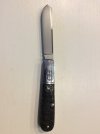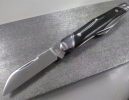bikerector
Knifemaker / Craftsman / Service Provider
- Joined
- Nov 16, 2016
- Messages
- 6,797
This is a guess but I think a lot has to do with the workability of the steel since many traditionals have multiple blades that means a lot of labor making the blade. The ones I've seen in modern steels cost a good bit more than the easier to work with steels.
I think most has to do with the limited market for traditionals and the need to get market share of that limited market. I also think most people getting traditionals are as concerned about fit and finish, maybe even considering it more important than materials choice. I know I've had a few knives with good steel but the F&F was not great and it ruined the knife for me, especially in regards to spring tension, where some cheap materialed knives with good F&F get the pocket time because they're a pleasure to use.
Lastly, I don't think you'll find as much need for a hard use metal on a traditional as they tend to not be used as hard. Obviously that's not always the case but my perception of those that carry slippies is usually more for EDC purposes and not processing a dear, a lot of cardboard, or things like that. I've found that most of the traditionals I've tried create hot spots so extended or hard uses didn't work so well unless the cutting media was softer, like food (really like mulit-blade slippies for food).
Most of my perceptions do not include single blade traditionals as I think they could really benefit and be more routinely used for hard use. I do consider traditional flavored lockbacks into the category, even though I go traditional only for mulit-blade and modern for single blade because I want one-hand operation if going single blade.
I think most has to do with the limited market for traditionals and the need to get market share of that limited market. I also think most people getting traditionals are as concerned about fit and finish, maybe even considering it more important than materials choice. I know I've had a few knives with good steel but the F&F was not great and it ruined the knife for me, especially in regards to spring tension, where some cheap materialed knives with good F&F get the pocket time because they're a pleasure to use.
Lastly, I don't think you'll find as much need for a hard use metal on a traditional as they tend to not be used as hard. Obviously that's not always the case but my perception of those that carry slippies is usually more for EDC purposes and not processing a dear, a lot of cardboard, or things like that. I've found that most of the traditionals I've tried create hot spots so extended or hard uses didn't work so well unless the cutting media was softer, like food (really like mulit-blade slippies for food).
Most of my perceptions do not include single blade traditionals as I think they could really benefit and be more routinely used for hard use. I do consider traditional flavored lockbacks into the category, even though I go traditional only for mulit-blade and modern for single blade because I want one-hand operation if going single blade.



